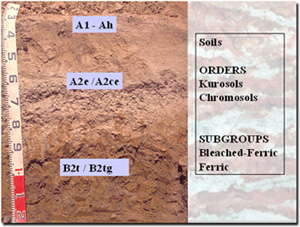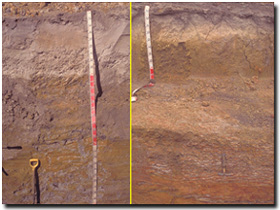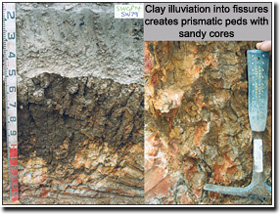Typical Soil Profiles
 |
Soils in the sedimentary plain are commonly texture contrast, with bleached (often spewy) subsurface (A2) horizons, overlying mottled, structured subsoil (B) horizons. Gravel and buckshot are common in the A2 horizons. Generally the profiles are strongly acid and fall into the Kurosol order of the Australian Soil Classification (Isbell 1996), though some are less acid in the upper subsoil and are therefore classified as Chromosols. Some others have sodic subsoils and are therefore classified as Sodosols.
The horizons are designated as: |
Two deep profiles are shown here, both having 1.5 to 2.0 metres soil depth overlying a weathered ferruginised regolith. The profile on the left shows a reticulate mottling pattern in the regolith while the profile on the right is exhibiting the ‘tiger mottle’ banding feature. |
 |
 | Not all the profiles on the plain are deep. Soils on the crests of rises or valley sides that have developed in the Hanson Plain Sand and Moorabool Viaduct parent materials are relatively shallow. These images are of a profile on the Moorabool Viaduct Formation, on the edge of the plain close to the Moorabool River. This profile has abundant gravel in the A2, a sharp boundary to the B horizon and an abrupt irregular boundary to the C horizon. The C horizon is an iron cemented sand which shows some weathering and loss of iron (paler areas). There are also many fissures and cracks in the C into which clay has illuviated i.e. washed down from the upper profile. The B horizon is prismatic medium heavy clay. However, when the prismatic peds are broken open, particularly in the lower B, sandy cores are revealed. The apparent clay prisms are in fact thick lenticular coatings of clay that have built up in the fractured regolith. The resultant structure has isolated fragments of hematite cemented sand. Subsequent weathering leaves these remnants as rounded and sub-rounded gravels. The hypothesis is that clay illuviation plays a significant role in the pedogenesis of these profiles in creating texture contrast soils and in wedging through the ferruginous regolith. |


